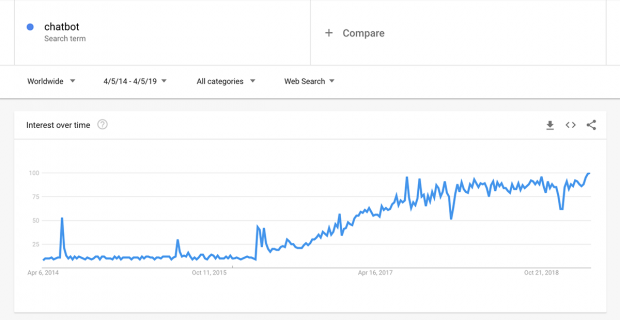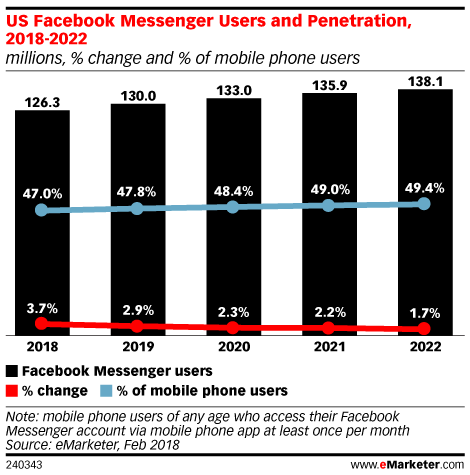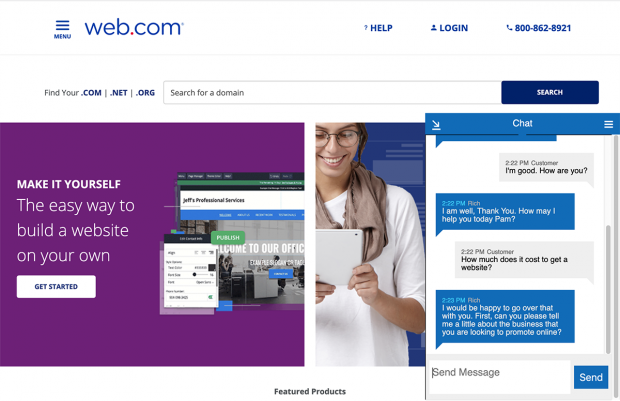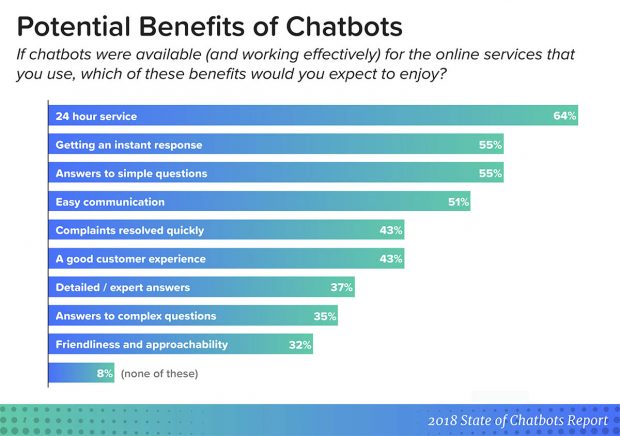Digital marketers have to know how to focus. To be effective, they must focus on marketing strategies and tactics that will actually work for them, and not get distracted by every fad that comes along.
Sometimes, it’s hard to tell a fad from a real opportunity. Chatbots are a good example of this. There’s been an awful lot of talk about them lately. And they sound like they could be an amazing tool.
But are chatbots really worth re-allocating precious resources away from other, proven marketing investments? Are they a fad… or worth prioritizing?

Before we get too deep into answering that question, let’s define what a chatbot is:
A chatbot is a piece of software that can automate conversations and engage in conversational marketing with a human user through various messaging platforms.
The chatbot can use either artificial intelligence or pre-programmed scripted responses. A chatbot that uses genuine artificial intelligence will be able to handle more tasks, and more sophisticated tasks, than a simpler pre-programmed bot.
Chatbots can communicate through several different channels:
- Facebook Messenger.
Facebook Messenger chatbots are very popular, but they only work on Facebook Messenger itself. You can also use Facebook Messenger bots to gather information about your users. You can then use that information to personalize the marketing messages they receive.
- Chat windows on a website.
These are usually placed on the bottom-right corner of the page. They look the same as a chat window a person would use to chat with a real person.
- Text-based or app-based chatbots.
There are several apps and services that offer information and guidance on different topics (eating well, dressing well, etc.) that are actually chatbots. These are automated interactions where the programming is sophisticated enough to appear to be a human, or at least human-like.
This aspect of appearing to be a sentient human is what makes chatbots so interesting. It’s also what can make chatbots verge on being true artificial intelligence: The classic test of an artificial intelligence, called the “Turing Test” or “The Imitation Game” “is a test of a machine’s ability to exhibit intelligent behavior equivalent to, or indistinguishable from, that of a human.”
Most chatbots aren’t anywhere near that sophisticated, but most people don’t really care. They’re willing to accept a “dumbed-down” chatbot over a human being if it can give them the answers they want. Especially if it can give them answers 24 hours a day, and give them answers instantly.
Some of the most sophisticated chatbots can be quite convincing… at least for the first few exchanges. You could set up your company’s chatbot so it could answer simple, routine questions and then hand a conversion over to a human being if the conversation became more complex.
This is somewhat similar to navigating a phone directory: The system is smart enough to recognize your responses, and can respond to them in a limited way. But once you hit a certain level of detail, a human has to step in.
The first exchanges in the chat in the Web.com screenshot above are simple enough for a chatbot to manage, but after I asked it one more question (“How much does a website cost?”), the chatbot asked to call me. A telephone call like that would be an ideal opportunity to pass the conversation from a chatbot to a person. A human operator would be able to see the prior conversation between me and the bot, and then pick up and offer details and expertise that beyond the chatbot’s capabilities.
So to answer our first question about whether chatbots are a fad or a real opportunity: Chatbots are a real opportunity. There’s just too much potential here for them to just be a fad. Chatbots can help with marketing functions, Customer Support, Lead Generation, even Human Resources work.
The next question is… is a chatbot right for your company, and for the specific tasks you’d like it to do?
How to tell if a chatbot is right for your business
If you’re not sure if a chatbot is necessary for your business, ask yourself:
- Do you have a messaging strategy in place, or do you receive the same questions over and over again from prospects or existing customers?
- Does your audience already use Facebook Messenger, or are they technologically adept enough to embrace a chatbot?
- Do you have the resources available to set up a chatbot and monitor how it performs?
If you answered “yes” to all those questions, your business would probably benefit from having a chatbot. The next thing to decide is what kind of chatbot you want, and what you want to use it for.
Businesses typically use chatbots for lead gen, sales, and/or customer support.
The process of qualifying leads can be repetitive. If your business already has a messaging strategy in place, the chatbot can automate it. This reduces the response rate time, and may help you close more leads.
According to Drift’s “2018 State of Chatbots” report:
“As research from InsideSales.com and the Harvard Business Review shows, even if you wait just five minutes to respond after a lead first reaches out, there’s a 10x decrease in your odds of actually getting in touch with that lead. After 10 minutes, there’s a 400% decrease in your odds of qualifying that lead.”
-
Chatbots for Sales
Just as content marketing can close sales by educating and entertaining customers through content, chatbots can sell goods and services by guiding prospects through the sales process and finding out which products would serve them best.
-
Chatbots for Customer Support
Do you get asked the same questions over and over and over? Then you probably have a Frequently Asked Questions page somewhere on your website. A chatbot can be the interactive version of that FAQ page.
Automating the responses to frequently asked questions is beneficial for both the customer care team and the customers. Customers receive quicker answers while reducing redundant questions in the queue. Any inquiries that are less common can be directed to a customer service agent.
The drawbacks of chatbots
Chatbots are promising, but they aren’t without their challenges. Here are some things you’ll have to resolve if you want your new chatbot to work.
Integration
A chatbot has to fit within your existing messaging systems. If it doesn’t, it can confuse customers, send them too many messages, and often cause more problems than it solves. In order to ensure the best customer experience, industry experts recommend having the database of the chatbot sync up with the rest of the company database.
User Language
Newsflash: People don’t always communicate in grammatically perfect English. They use slang, they mistype words… sometimes they don’t even make sense to other humans. This is a problem for chatbots. It’s frustrating if a bot keeps suggesting the wrong solution to your problem simply because it’s not programmed to understand how you write or talk.
User adoption
Not everyone loves chatbots. Some of your customers and prospects, for whatever reason, will simply resist using them. If your user base is not particularly tech savvy, you might not get as high an adoption rate as you’d like.
How much do chatbots cost?
This is a little bit like asking how much a website costs. It depends on the website.
According to Azati Software, a reasonably sophisticated chatbot (that can handle basic customer questions, and handle some lead qualification) will cost “from $15,000 to $30,000 for a custom bot.”
They add: “The companies located in Silicon Valley set a minimum price of $30,000 for a pretty simple bot that is able to reply to various users’ questions. The price for a very sophisticated AI-chatbot for customer support ranges from $40,000 to $100,000.“
That’s considerably more than the cost of a basic Facebook Messenger bot from a service like MobileMonkey. The cost for a tool like that, which can handle very simple messaging, is $19-49 a month. Or you could test out something like SnatchBot, which is actually free ($30 for the “Pro” plan, which is what you’ll probably end up needing).
Given how vastly different these price points are, you can see why it’s a bit of a guess how much a useful, business-building chatbot may cost you.
Our advice? Start with a good, basic tool like MobileMonkey or SnatchBot (or any of the many other similar services), then see how your customers and prospects respond. Get a feel for how a chatbot will fit into your current customer support and sales systems. Then – if the chatbot does work for you – think about investing $15,000 or more for a more sophisticated chatbot. Who knows… maybe you’ll be able to get 80% of the value of a sophisticated bot from a well-designed Facebook Messenger bot or similar tool. And you’ll have saved $15,000+.
As you do your calculations, be sure to account for these five things when planning out the true cost of maintaining your bot:
- Producing content.
Even if you are planning to use existing messaging, don’t underestimate the time it takes to prepare content on a new platform.
- Testing.
Once the content has been loaded, you can’t skip testing. Run a trial internally before releasing it to the public.
- Monitoring interactions.
After launch, consistently gather data and measure whether the desired outcome was achieved. Inken Kuhlmann-Rhinow, Marketing Director, EMEA, HubSpot advises:
You must clearly define the goals of a chatbot and start small. When starting out, companies shouldn’t expect their first chatbot to do everything at once. Start with really clear goals such as taking a booking or handling a simple customer query. This will gently introduce a chatbot to a company’s customer base and allow the company to test out the bot without exposing it to too much risk and ruining a relationship.
- Analyzing data.
Based on the data, make an assessment of your bot’s performance to date and determine what customers want more of, and what can be eliminated.
- Modifications and Improvements.
Make necessary tweaks based on the assessment and continue to improve the customer experience.
Conclusion
Chatbots are promising. Many consumers are already using them, and many more would use them if they were available. Chatbots have been proven to reduce wait times, increase engagement, and they are definitely on their way to being as valuable a communication channel as email and phone calls.
So yes, a chatbot could help your business. The real questions are:
- How sophisticated a chatbot will you need?
- How well will it fit with your existing communication channels and messaging?
- How will your customers respond to it?
We’ll leave it to you to figure that out.
IMAGES
- Unsplash, Daniel Frank.
- Google Trends screenshot taken by author April, 2019.
- eMarketer, US Facebook Messenger Users and Penetration, 2018-2022 (millions, % change and % of mobile phone users).
- Screenshot of Web.com homepage, taken by author April, 2019.
- Drift’s “2018 State of Chatbots” report.
- Drift’s “2018 State of Chatbots” report.






